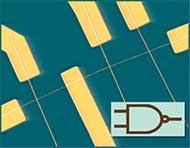A little logic goes a long way

Nano-circuits promise powerful palmtops. <br>© Y. Huang, X. Duan and C.M. Lieber, Harvard University
Ultra-minaturized electrical components could shrink supercomputers.
Researchers in the Netherlands and the United States have constructed simple computer circuits with electrical components many times smaller than those on commercial silicon chips1,2. These ultra-minaturized logic circuits hold out the prospect of hand-held computers as powerful as today’s state-of-the-art supercomputers.
Cees Dekker and co-workers at the Delft University of Technology in the Netherlands have used single molecules to produce logic circuits capable of basic arithmetical calculations1. The molecules are carbon nanotubes, tiny tubes of pure carbon just a few millionths of a millimetre (nanometres) wide.
A second team at Harvard University in Cambridge, Massachusetts, led by Charles Lieber, have produced similar circuits from wires of similar size to carbon nanotubes, but made from the semiconducting materials silicon and gallium nitride2. Lieber’s group previously perfected methods for growing these ’nanowires’ to specified dimensions and chemical composition.
Conventional diodes and transistors are etched out of flat sandwiches of silicon and other materials using acids. This approach struggles to make components smaller than about 200 nanometres across. Dekker and Lieber assemble their devices atom by atom. It is the difference between an artist chiselling away at a block of wood or gluing together matchsticks.
Carbon-nanotube transistors and even logic circuits have been made before. In 1998, Dekker’s group was the first to build a nanotube transistor; and last June, a team from IBM’s research laboratories in Yorktown Heights, New York, created logic circuits, called NOT gates, from nanotube transistors3. Dekker and colleagues have now wired up groups of nanotubes to make a variety of logic circuits, including a memory cell that could form part of a random-access memory.
One of the difficulties in making nanotube circuits on a large scale, Lieber points out, is that it is very hard to control the way the tubes conduct electricity. Some nanotubes are like metal wires, others act like semiconductors such as silicon. To make a nanotube transistor requires semiconducting rather than metallic conduction. But which kind of tube you get using existing synthesis methods is largely a matter of chance.
Lieber has much more control over the electrical properties of his nanowires. Transistors and other elements of logic circuits typically require two kinds of semiconductor, called p-type and n-type. The electrical currents are carried in these by positively and negatively charged particles, respectively. Lieber can grow both p- and n-type semiconducting nanowires.
Lieber crosses p-type silicon nanowires at right angles to n-type gallium-nitride nanowires. Devices form at the crossing points. By wiring several different devices together, the researchers produce all the major logic gates of computer circuitry.
References
- Bachtold, A. Hadley, P. Nakanishi, T. Dekker, C. Logic circuits with carbon nanotube transistors. Science, 294, 1317 , (2001).
- Huang, Y. et al. Logic gates and computation from assembled nanowire building blocks. Science, 294, 1313 – 1317, (2001).
- Derycke, V. Martel, R. Appenzeller, J. & Avouris, Ph.Carbon nanotube inter- and intramolecular logic gates. Nano Letters, 9, 453 – 456 , (2001).
Media Contact
More Information:
http://www.nature.com/nsu/011115/011115-1.htmlAll latest news from the category: Information Technology
Here you can find a summary of innovations in the fields of information and data processing and up-to-date developments on IT equipment and hardware.
This area covers topics such as IT services, IT architectures, IT management and telecommunications.
Newest articles

NASA: Mystery of life’s handedness deepens
The mystery of why life uses molecules with specific orientations has deepened with a NASA-funded discovery that RNA — a key molecule thought to have potentially held the instructions for…

What are the effects of historic lithium mining on water quality?
Study reveals low levels of common contaminants but high levels of other elements in waters associated with an abandoned lithium mine. Lithium ore and mining waste from a historic lithium…

Quantum-inspired design boosts efficiency of heat-to-electricity conversion
Rice engineers take unconventional route to improving thermophotovoltaic systems. Researchers at Rice University have found a new way to improve a key element of thermophotovoltaic (TPV) systems, which convert heat…



